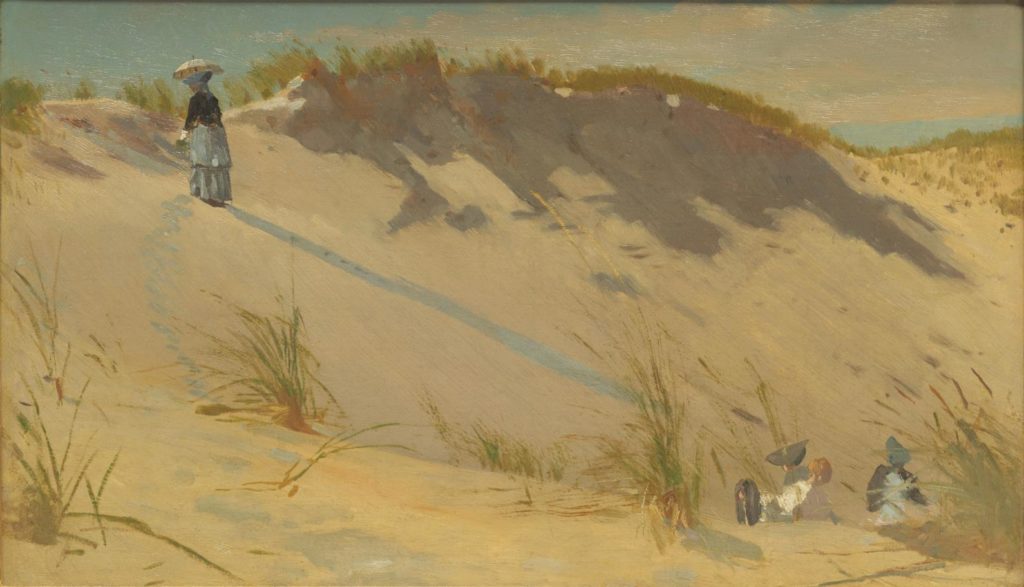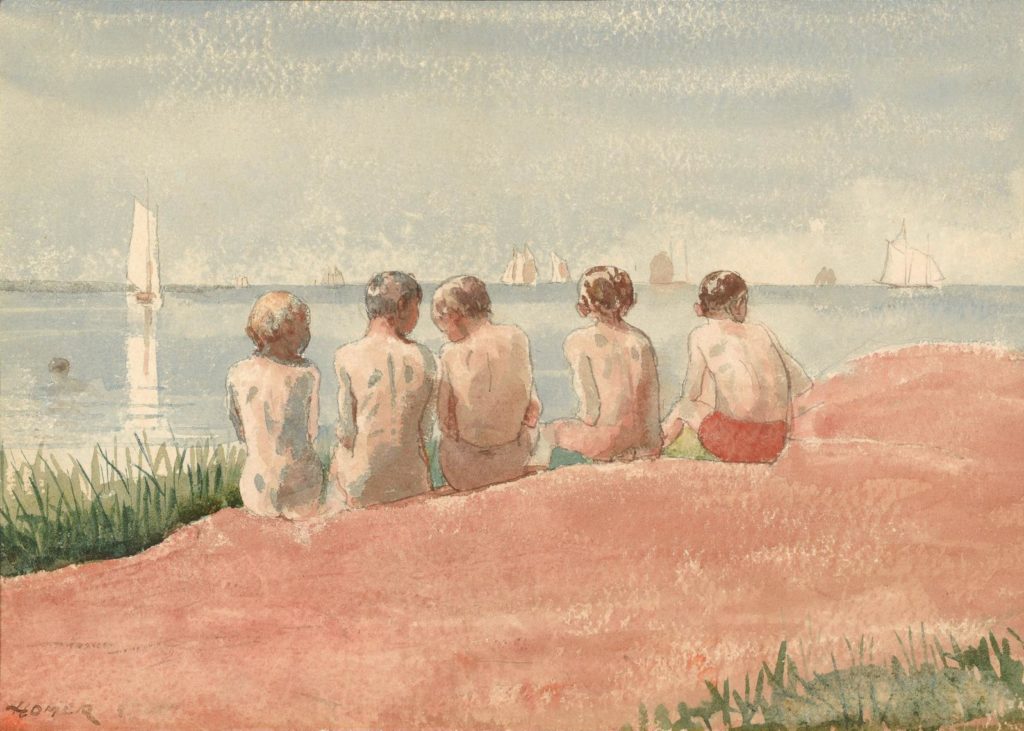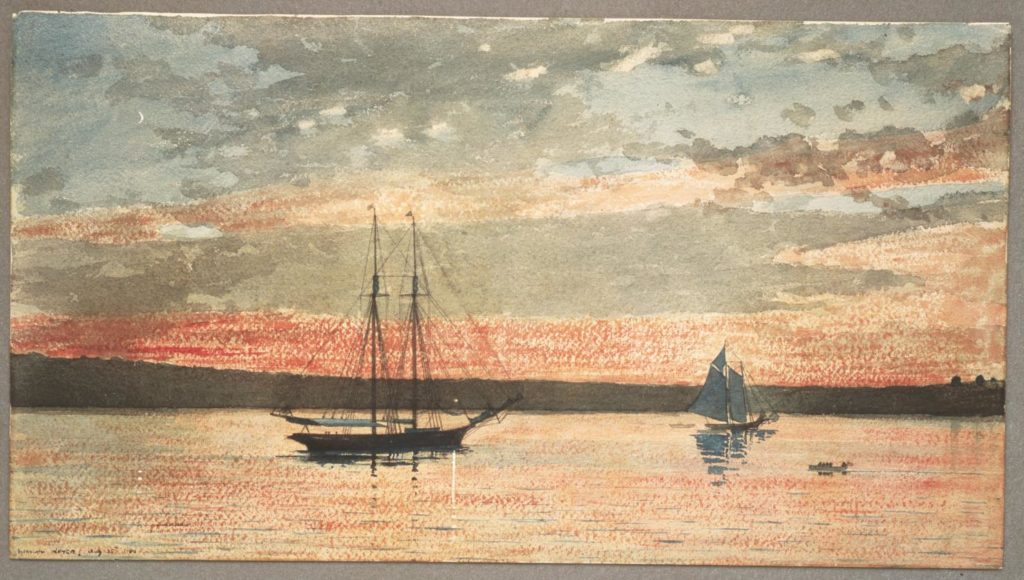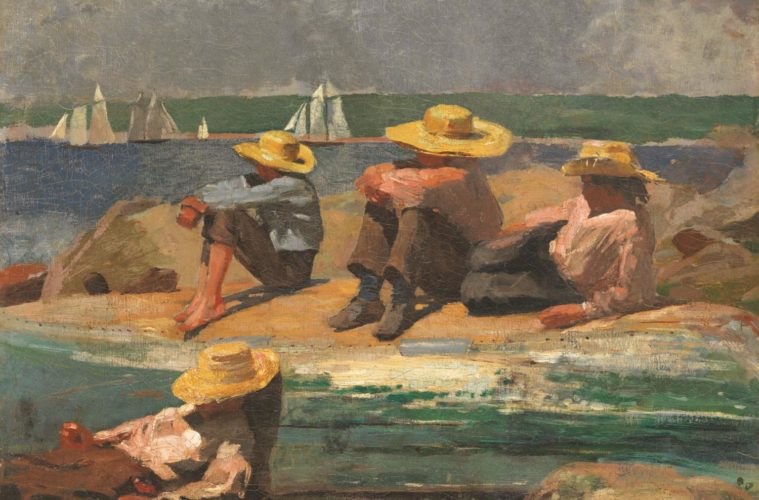The enchanting power of the ocean and one artist who mined its possibilities shapes the theme of Homer at the Beach: A Marine Painter’s Journey, 1869-1880 at the Cape Ann Museum in Gloucester (August 3 to December 1, 2019). Co-curator William Cross explains that he began with a basic question: “How did a relatively little-known American with ambition and talent become the great marine painter that we know today?”
To arrive at a concrete answer, Cross and co-curator Henry Adams narrowed their focus to the art Homer created across six locations, including Gloucester, where he summered during two seminal years, 1873 and 1880, and where he found fresh subjects and evolved distinctive approaches to his work. As he once told a contemporary writer on art: “You have the sky overhead giving one light; then the reflected light from whatever it reflects; then the direct light of the sun; so that, in the blending and suffusing of these several luminations, there is no such thing as a line to be seen anywhere.”

The exhibit comprises 51 original Homer works from 40 lenders plus 45 contextualizing objects to provide viewers with a sense of time and place. There’s a variety of media: watercolors, oil paintings, tile paintings, and other kinds of drawings. Homer was judicious in his risks where other artists might have been reluctant to stretch their talents. Experimentation was, it seems, a driving force. Criticized by the art establishment once he entered exhibitions, he soldiered on, adhering to his own evolving aesthetic, developed and expanded from a solid foundation laid during his early years as an illustrator for the widely circulated Harper’s Weekly.
For Homer the summer of 1873 in Gloucester was a period of transition and redirection. He discovered the expressive possibilities of watercolor painting. In addition, he found a favorite subject: childhood, already popular in the national consciousness. Memories of the trauma of the Civil War still were still present in people’s minds along with the throes of social upheaval and the harsh effects of industrialism. It seemed a natural response to look back at a simpler past.
So Homer turned to childhood for inspiration. His art from this period often reflects a down-to-earthness—simple people, living simple lives, doing simple things in their own environment. The sea is largely a pleasant backdrop to the subjects’ in front of it. One common concept, the “Bad Boy,” who came to exemplify a quaint purity. Sure, boys had fun doing what had boys always done, but now in art, poetry, magazines, and novels their ingenuousness struck a note of common affection. Most famous in literature were Mark Twain’s iconic Tom Sawyer and Huck Finn, who endure to this day. Boyhood depictions were Homer’s painterly nod to lost innocence.
In Five Boys at the Shore, the subjects have their backs to us; the sun is gleaming off the sea and sky, and boats are floating in the pastel backdrop. Cross points out that “some are wearing bathing suits and some are not.” Innocent or not, to the growing numbers of tourists gravitating to Gloucester during the summer, boys going au naturel tested Victorian propriety. It’s a snapshot in time, but in actuality the “risqué” behavior forced locals to reevaluate perceptions of innocence. “Laws were passed: Thou shalt wear bathing suits,” Cross says. “Gloucester newspapers carried stories stating that you could be arrested for not wearing a bathing suit.”
Other paintings show boys idling on outcroppings, their faces shadowed beneath straw hats. In their anonymity, Homer reaches out for a universal essence of childhood rather than the particulars of one individual’s experiences. Such everyday activity brings to my mind John Updike’s observation about his duty to writing: “to give the mundane its beautiful due.”

Homer began the beach scene By the Shore in New Jersey and finished it in Manchester, Massachusetts. In the foreground, three women, posh in their in Victorian bustle dresses, lounge beneath parasols. In their gaze, six bathers, all women in their “water-cure costumes” (swimsuits), splash playfully through the incoming tide. Our attention is drawn to the left to the woman leaning forward, lifting and squeezing excess seawater from her gray swimsuit trimmed in red, her soaked red hair falling over her face. Through meticulous research, consulting costume historian Lynne Bassett discovered a matching original swimsuit at the Chenango County Historical Society in Norwich, New York, apparently made by the same manufacturer. “We’re bringing it back to go with the painting,” Cross says. “Believe it or not, the origins of women’s bathing suits are in Islamic women’s clothing.”
For a short period Homer found another surface for his artistic impulses—ceramic tile. Just for fun he met on Wednesday evenings in Greenwich Village with a group of artists who painted scenes on clay surfaces before they were fired in a kiln. Four of the tiles are exhibited. Couple on the Shore, in dominant blue tones, could complement any decor in a seaside summer home.
In 1880, Homer returned to Gloucester, boarding with a lighthouse keeper and his family on Ten Pound Island. Over the previous seven years his artistic identity, direction, and painting style had evolved, and he recalibrated his approach. His focus shifted from narrative potential to a growing interest in the effects of light and atmosphere. Environment appears to take precedence in these works; humans seem part of the background.


Great forces of nature, the sky and the sea, became important subjects. The boyhood motif was replaced by boats—particularly the schooners, a Gloucester invention, which became emblematic of the great eastern port itself. To help contextualize the artist’s newfound emphasis, a distinctive double-ended working vessel like the one he painted in York, Maine, was borrowed from the Mystic Seaport Museum for display here.
Homer also shifted to larger pieces of paper as his themes expanded. “He’s looking at the world with an eye to telling the truths in his own way,” Cross says. Missing is the cartographer’s scientific reality, replaced by how the new reality “meets his eye.” To recently appointed director Oliver Barker, the exhibit is a thrilling entrée to this outstanding regional museum. “It is an important step as we think about building up to our 150th anniversary in 2023 and Gloucester’s 400th.”

